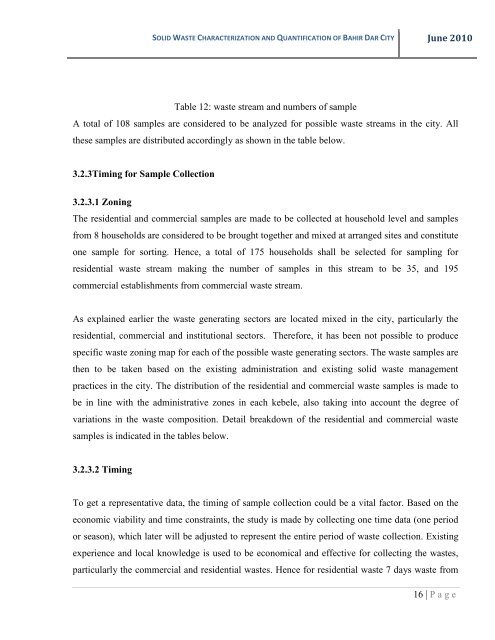solid waste characterization and quantification of bahir dar city for ...
solid waste characterization and quantification of bahir dar city for ...
solid waste characterization and quantification of bahir dar city for ...
Create successful ePaper yourself
Turn your PDF publications into a flip-book with our unique Google optimized e-Paper software.
SOLID WASTE CHARACTERIZATION AND QUANTIFICATION OF BAHIR DAR CITY June 2010<br />
Table 12: <strong>waste</strong> stream <strong>and</strong> numbers <strong>of</strong> sample<br />
A total <strong>of</strong> 108 samples are considered to be analyzed <strong>for</strong> possible <strong>waste</strong> streams in the <strong>city</strong>. All<br />
these samples are distributed accordingly as shown in the table below.<br />
3.2.3Timing <strong>for</strong> Sample Collection<br />
3.2.3.1 Zoning<br />
The residential <strong>and</strong> commercial samples are made to be collected at household level <strong>and</strong> samples<br />
from 8 households are considered to be brought together <strong>and</strong> mixed at arranged sites <strong>and</strong> constitute<br />
one sample <strong>for</strong> sorting. Hence, a total <strong>of</strong> 175 households shall be selected <strong>for</strong> sampling <strong>for</strong><br />
residential <strong>waste</strong> stream making the number <strong>of</strong> samples in this stream to be 35, <strong>and</strong> 195<br />
commercial establishments from commercial <strong>waste</strong> stream.<br />
As explained earlier the <strong>waste</strong> generating sectors are located mixed in the <strong>city</strong>, particularly the<br />
residential, commercial <strong>and</strong> institutional sectors. There<strong>for</strong>e, it has been not possible to produce<br />
specific <strong>waste</strong> zoning map <strong>for</strong> each <strong>of</strong> the possible <strong>waste</strong> generating sectors. The <strong>waste</strong> samples are<br />
then to be taken based on the existing administration <strong>and</strong> existing <strong>solid</strong> <strong>waste</strong> management<br />
practices in the <strong>city</strong>. The distribution <strong>of</strong> the residential <strong>and</strong> commercial <strong>waste</strong> samples is made to<br />
be in line with the administrative zones in each kebele, also taking into account the degree <strong>of</strong><br />
variations in the <strong>waste</strong> composition. Detail breakdown <strong>of</strong> the residential <strong>and</strong> commercial <strong>waste</strong><br />
samples is indicated in the tables below.<br />
3.2.3.2 Timing<br />
To get a representative data, the timing <strong>of</strong> sample collection could be a vital factor. Based on the<br />
economic viability <strong>and</strong> time constraints, the study is made by collecting one time data (one period<br />
or season), which later will be adjusted to represent the entire period <strong>of</strong> <strong>waste</strong> collection. Existing<br />
experience <strong>and</strong> local knowledge is used to be economical <strong>and</strong> effective <strong>for</strong> collecting the <strong>waste</strong>s,<br />
particularly the commercial <strong>and</strong> residential <strong>waste</strong>s. Hence <strong>for</strong> residential <strong>waste</strong> 7 days <strong>waste</strong> from<br />
16 | P a g e
















